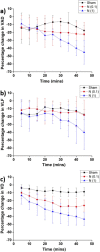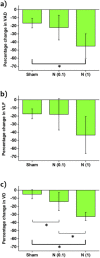Optical coherence tomography angiography to evaluate murine fetal brain vasculature changes caused by prenatal exposure to nicotine
- PMID: 33014555
- PMCID: PMC7510910
- DOI: 10.1364/BOE.394905
Optical coherence tomography angiography to evaluate murine fetal brain vasculature changes caused by prenatal exposure to nicotine
Abstract
Maternal smoking causes several defects ranging from intrauterine growth restriction to sudden infant death syndrome and spontaneous abortion. While several studies have documented the effects of prenatal nicotine exposure in development and behavior, acute vasculature changes in the fetal brain due to prenatal nicotine exposure have not been evaluated yet. This study uses correlation mapping optical coherence angiography to evaluate changes in fetal brain vasculature flow caused by maternal exposure to nicotine during the second trimester-equivalent of gestation in a mouse model. The effects of two different doses of nicotine were evaluated. Results showed a decrease in the vasculature for both doses of nicotine, which was not seen in the case of the sham group.
© 2020 Optical Society of America under the terms of the OSA Open Access Publishing Agreement.
Conflict of interest statement
The authors declare that there are no conflicts of interest related to this article.
Figures





Similar articles
-
Assessing the effects of prenatal poly-drug exposure on fetal brain vasculature using optical coherence angiography.J Biomed Opt. 2023 Jul;28(7):076002. doi: 10.1117/1.JBO.28.7.076002. Epub 2023 Jul 18. J Biomed Opt. 2023. PMID: 37469831 Free PMC article.
-
Dose-response analysis of microvasculature changes in the murine fetal brain and the maternal extremities due to prenatal ethanol exposure.J Biomed Opt. 2020 Nov;25(12):126001. doi: 10.1117/1.JBO.25.12.126001. J Biomed Opt. 2020. PMID: 33244919 Free PMC article.
-
Assessing the acute effects of prenatal synthetic cannabinoid exposure on murine fetal brain vasculature using optical coherence tomography.J Biophotonics. 2019 Aug;12(8):e201900050. doi: 10.1002/jbio.201900050. Epub 2019 Apr 21. J Biophotonics. 2019. PMID: 30887665 Free PMC article.
-
Behavioral and neural consequences of prenatal exposure to nicotine.J Am Acad Child Adolesc Psychiatry. 2001 Jun;40(6):630-41. doi: 10.1097/00004583-200106000-00007. J Am Acad Child Adolesc Psychiatry. 2001. PMID: 11392340 Review.
-
Respiratory dysfunctions induced by prenatal nicotine exposure.Clin Exp Pharmacol Physiol. 2009 Dec;36(12):1205-17. doi: 10.1111/j.1440-1681.2009.05214.x. Epub 2009 May 19. Clin Exp Pharmacol Physiol. 2009. PMID: 19473189 Review.
Cited by
-
Optical coherence tomography for noninvasive monitoring of drug delivery.Adv Drug Deliv Rev. 2025 May;220:115571. doi: 10.1016/j.addr.2025.115571. Epub 2025 Mar 24. Adv Drug Deliv Rev. 2025. PMID: 40139506 Free PMC article. Review.
-
Assessing the effects of prenatal poly-drug exposure on fetal brain vasculature using optical coherence angiography.J Biomed Opt. 2023 Jul;28(7):076002. doi: 10.1117/1.JBO.28.7.076002. Epub 2023 Jul 18. J Biomed Opt. 2023. PMID: 37469831 Free PMC article.
-
Dose-response analysis of microvasculature changes in the murine fetal brain and the maternal extremities due to prenatal ethanol exposure.J Biomed Opt. 2020 Nov;25(12):126001. doi: 10.1117/1.JBO.25.12.126001. J Biomed Opt. 2020. PMID: 33244919 Free PMC article.
-
Embryonic Mouse Cardiodynamic OCT Imaging.J Cardiovasc Dev Dis. 2020 Oct 4;7(4):42. doi: 10.3390/jcdd7040042. J Cardiovasc Dev Dis. 2020. PMID: 33020375 Free PMC article. Review.
-
Mouse embryo phenotyping with optical coherence tomography.Front Cell Dev Biol. 2022 Sep 9;10:1000237. doi: 10.3389/fcell.2022.1000237. eCollection 2022. Front Cell Dev Biol. 2022. PMID: 36158219 Free PMC article. Review.
References
-
- Drake P., Driscoll A. K., Mathews T. J., “Cigarette Smoking During Pregnancy: United States, 2016,” NCHS Data Brief 305, 1–8 (2018). - PubMed
-
- D’Onofrio B. M., Turkheimer E. N., Eaves L. J., Corey L. A., Berg K., Solaas M. H., Emery R. E., “The role of the children of twins design in elucidating causal relations between parent characteristics and child outcomes,” J. Child Psychol. Psychiatry 44(8), 1130–1144 (2003).10.1111/1469-7610.00196 - DOI - PubMed
Grants and funding
LinkOut - more resources
Full Text Sources
